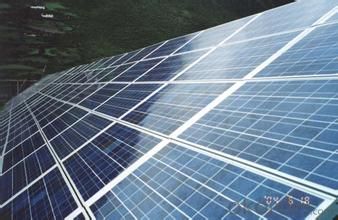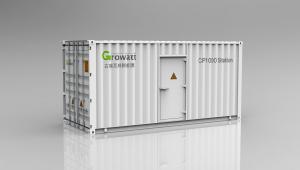Centralized Solar Inverter CP1000 Station,1260KW with TUV,EPEA,MEA,CE,CGC,LVRT,ZVRT 1.26MW
- Loading Port:
- Shekou
- Payment Terms:
- TT or LC
- Min Order Qty:
- 20 pc
- Supply Capability:
- 1000 pc/month
OKorder Service Pledge
OKorder Financial Service
You Might Also Like
1000kW integrated central inverter solution with DC distributed box and ac distributed box.
High conversion efficiency of 98.7% deliver more energy
Powerful grid management functions (including LVRT)
Active power continuous adjustment (0-100%)
Reactive power continuous adjustment (0-100%)
Integrated with SCADA monitoring system, totally compatible with smart-grid interface
Intelligent control, entirely meet the requirements of grid
Provide a turnkey solution, easy installation and maintenance
Comprehensive protection for overvoltage, islanding, short-circuit, overload, etc.
| CP1000 Station | CP1260 Station | |||
| Input data | ||||
| Max. DC power | 1150kW | 1450kW | ||
| Max. DC voltage | 1000V | 1000V | ||
| PV voltage range | 500V-1000V | 500V-1000V | ||
| MPP voltage range/nominal voltage | 500V-850V | 500V-850V | ||
| Rated Input voltage | 600V | 600V | ||
| Start voltage/power | 520V/10000W | 520V/12600W | ||
| Maximum Input current | 2240A | 2900A | ||
| Number of MPP trackers/strings per MPP tracker | 1 | 1 | ||
| Max. input current/per string | 2*10 | 2*10 | ||
| Output (AC) | ||||
| Rated AC output power | 1000kVA | 1000kVA | ||
| Rated AC voltage | 315V | 315V | ||
| AC voltage range | 250V-362V | 250V-362V | ||
| Rated frequency | 50Hz/60Hz | 50Hz/60Hz | ||
| Frequency Range | 45Hz-55Hz/55Hz-65Hz | 45Hz-55Hz/55Hz-65Hz | ||
| Rated Output Current | 1833A | 2310A | ||
| Maximum Output Current | 2016A | 2592A | ||
| Power factor | 0.9lagging-0.9leading | 0.9lagging-0.9leading | ||
| THDI | <3%(@Pac,r) | <3%(@Pac,r) | ||
| Efficiency | ||||
| Max. efficiency | 98.70% | 98.70% | ||
| Euro-eta | 98.50% | 98.50% | ||
| MPPT efficiency | 99.9% | 99.90% | ||
| Protection Devices | ||||
| DC disconnection device | DC circuit breaker | DC circuit breaker | ||
| AC disconnection device | AC circuit breaker | AC circuit breaker | ||
| DC overvoltage protection | Surge arrester type II | Surge arrester type II | ||
| AC overvoltage protection | Surge arrester type II | Surge arrester type II | ||
| Grid monitoring/Management | yes/yes | yes/yes | ||
| Ground monitoring | yes | yes | ||
| Over temperature protection | yes | yes | ||
| Insulation monitoring | yes | yes | ||
| General data | ||||
| Dimension (W/H/D)in mm | 3600/3000/2896 | 3600/3000/2896 | ||
| Weight | 6000KG | 6000KG | ||
| Operating Temperature Range | -25℃ ... +55℃ | -25℃ ... +55℃ | ||
| Relative Humidity | 0~95% | 0~95% | ||
| Degree of Protection | IP54 | IP54 | ||
| Noise Emission | 65dB(A)@1m | 65dB(A)@1m | ||
| Maximum Operating Altitude | 6000m(Derating over 3000m) | 6000m(Derating over 3000m) | ||
| Standby consumption | <200W | <200W | ||
| Cooling | Air forcedl | Air forcedl | ||
| Topology | Transformerless | Transformerless | ||
| Display | Touch screen LCD | Touch screen LCD | ||
| Communication Interface | RS485/Ethernet | RS485/Ethern | ||
| Certificates and ApprovalsCE, TUV, CGC, LVRT, ZVRT, PEA, G59 | ||||


FAQ
1. Have any design tool and how to use it?
Shine Design is the system design software just for inverters, It can conduct installers to figure out panel numbers for a system, panel numbers for each string, and which inverter model is suitable for the system. Moreover, it can print a design report after input all necessary parameters, can calculate DC/AC wire wastage, annual generation, etc.
2. Does the inverter have monitoring solutions for residential system?
For small rating system, we have wired two monitoring solution (ShineNet via RS232 or RS485). (a) Local wireless monitoring solution (ShineVision via RF module communication) (b) Global wireless monitoring solution (WIFI module via WIFI network)
3. Do you have free solution for monitoring?
ShineNet is an inverter monitoring software run in Windows XP, Windows Vista, Windows 7 operating system. It can monitor inverter via RS232 (or RS232 convert to USB cable) and RS485 wire connection. Customers can purchase the cable locally to get the inverter monitored, it is simple.
- Q:Can a solar inverter be used with different types of backup power sources?
- Yes, a solar inverter can be used with different types of backup power sources. Solar inverters are designed to convert the direct current (DC) generated by solar panels into alternating current (AC) that can be used to power electrical devices. They can be integrated with various backup power sources such as batteries, generators, or the grid. This flexibility allows for a reliable and uninterrupted power supply, utilizing solar energy as the primary source while seamlessly switching to alternative power sources when needed.
- Q:What is the role of a solar inverter in fault ride-through capability?
- The role of a solar inverter in fault ride-through capability is to help maintain the stability and reliability of the power grid during faults or disturbances. By detecting and responding to voltage and frequency variations caused by faults, the solar inverter can adjust its output and remain connected to the grid, ensuring continuous power supply. This capability is essential for grid stability and allows solar power systems to contribute to the overall reliability of the electrical network.
- Q:Can a solar inverter be used with different solar panel types?
- Solar inverters are capable of being utilized with various types of solar panels. Their purpose is to convert the direct current generated by solar panels into alternating current, which is suitable for powering household appliances and injecting into the electrical grid. So long as the solar panels produce compatible levels of DC voltage and current, they can be connected to the solar inverter. Various solar panel types, such as monocrystalline, polycrystalline, and thin-film, may possess different electrical characteristics. However, modern solar inverters are typically equipped with advanced electronics that can adapt to these discrepancies. Nevertheless, it is crucial to ensure the solar inverter is appropriately matched with the solar panel specifications in order to achieve optimal performance and efficiency.
- Q:Can a solar inverter be used with a generator as a backup power source?
- Yes, a solar inverter can be used with a generator as a backup power source. The solar inverter can be connected to the generator's output, allowing it to convert the DC power produced by the generator into AC power that can be used by various electrical devices. This setup enables the solar inverter to utilize the generator as an alternative power source when solar energy is not available, ensuring continuous electricity supply.
- Q:How does a solar inverter handle harmonics in the grid?
- A solar inverter handles harmonics in the grid by incorporating a built-in filter that helps mitigate the impact of harmonics. This filter is designed to reduce the distortion caused by harmonics, ensuring that the inverter's output adheres to the required grid standards. Additionally, advanced inverters may also employ control algorithms that actively monitor and adjust the output waveform to minimize harmonic distortion and maintain grid stability.
- Q:Can a solar inverter be used with a solar-powered EV charging network?
- Yes, a solar inverter can be used with a solar-powered EV charging network. A solar inverter converts the direct current (DC) electricity generated by solar panels into alternating current (AC) electricity, which is used to power electric vehicles (EVs) through the charging network. This allows for the efficient and sustainable use of solar energy to charge EVs.
- Q:Can a solar inverter be used with building-integrated photovoltaics (BIPV)?
- Yes, a solar inverter can be used with building-integrated photovoltaics (BIPV). The solar inverter is an essential component that converts the DC power generated by the BIPV system into AC power suitable for use in buildings. It ensures efficient utilization of the solar energy produced by the BIPV system and enables integration with the electrical grid or building's power system.
- Q:What is the role of a solar inverter in a solar-powered remote monitoring system?
- The role of a solar inverter in a solar-powered remote monitoring system is to convert the direct current (DC) electricity generated by the solar panels into alternating current (AC) electricity that can be used to power the monitoring system. It also ensures that the electricity generated matches the requirements of the monitoring equipment, regulates the voltage, and assists in efficient power transmission and distribution.
- Q:Can a solar inverter be used in conjunction with a battery management system?
- Yes, a solar inverter can be used in conjunction with a battery management system. In fact, many solar energy systems utilize both components together to optimize energy generation, storage, and usage. The solar inverter converts the DC power generated by solar panels into AC power for immediate use or to be fed back into the grid. Meanwhile, the battery management system manages the charging, discharging, and overall performance of the batteries, ensuring efficient energy storage and distribution.
- Q:What is the lifespan of the capacitors in a solar inverter?
- The lifespan of capacitors in a solar inverter can vary depending on various factors, such as the quality of the components, operating conditions, and maintenance. Generally, high-quality capacitors can have a lifespan of around 10 to 15 years. However, it is important to regularly monitor and maintain the inverter to ensure optimal performance and longevity of the capacitors.
1. Manufacturer Overview |
|
|---|---|
| Location | |
| Year Established | |
| Annual Output Value | |
| Main Markets | |
| Company Certifications | |
2. Manufacturer Certificates |
|
|---|---|
| a) Certification Name | |
| Range | |
| Reference | |
| Validity Period | |
3. Manufacturer Capability |
|
|---|---|
| a)Trade Capacity | |
| Nearest Port | |
| Export Percentage | |
| No.of Employees in Trade Department | |
| Language Spoken: | |
| b)Factory Information | |
| Factory Size: | |
| No. of Production Lines | |
| Contract Manufacturing | |
| Product Price Range | |
Send your message to us
Centralized Solar Inverter CP1000 Station,1260KW with TUV,EPEA,MEA,CE,CGC,LVRT,ZVRT 1.26MW
- Loading Port:
- Shekou
- Payment Terms:
- TT or LC
- Min Order Qty:
- 20 pc
- Supply Capability:
- 1000 pc/month
OKorder Service Pledge
OKorder Financial Service
Similar products
New products
Hot products
Hot Searches
Related keywords

































